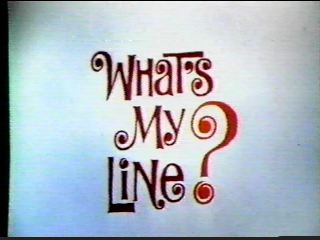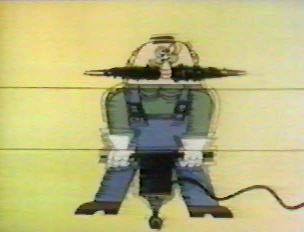What's My Line? 1968-1975
Print ads promoting WML's return in 1968







Broadcast History:
Syndicated to local stations by Viacom
Aired five days a week
First show: 9/9/68
Last Show: 9/75


Hosts: Wally Bruner (9/68-9/72) and Larry Blyden (9/72-9/75)
Announcers: Johnny Olsen, Chet Gould, Wayne Howell, and Dennis Wholey
Producer: Gil Fates
Director: Lloyd Gross
Set Designers: Ron Baldwin, Ted Cooper
Music: Score Productions
Origination: Ed Sullivan Theater, New York (1968 - 1971), NBC Studios 8H and 6A, New York (1971-1975)
Regular panelists


Arlene Francis and Soupy Sales
Frequent guest panelists included: Gene Rayburn, Bert Convy, Larry Blyden, Gene Shalit, Dana Valery, Ruta Lee, and Alan Alda.
When What's My Line? ended its run in 1967, Goodson-Todman only had three shows left, all running daily on daytime television:
To Tell the Truth, The Match Game, and Snap Judgement
Both Truth and Snap were gone the next year, with only Match running. Goodson-Todman executives had to do something, since they didn't want to be a one show company.
They came up with an idea: Why not bring back What's My Line? as a daily show running five times a week?
So rather than pitch the ideas to the networks, they turned to the newly formed production company Viacom (formerly known as CBS Films, spun-off from CBS in 1971, re-merged in 1999, then spun-off again in 2006) and asked them to syndicate the new show to local stations. A deal was successfully worked out and by the fall of 1968, Line would return.
One thing Goodson-Todman did was something unheard of at the time: Produce five shows in one day! Now with videotape becoming a standard, five shows would be taped, edited, and sent out to stations all over the nation. It's a practice that is now the norm in today's industry!
Five shows in one day meant this: The same four panelists for the entire week, plus ten contestants and five mystery guests were needed. At first it was assumed impossible, but it was accomplished!

A new, "mod", set was designed for the new Line, featuring icons of different trades behind the panel and host, a new chalkboard inside a fancy display that can be rolled away off stage, and a center stage with a curtain and the WML logo hanging above.
The animated intro used during the final two years on CBS returned (It was shot in color) to open each show.
New music, including a new theme song, was recorded by Score Productions.
And of course, a new host was needed.

With John Daly now working as the Voice of America, the producers discovered Daly's perfect replacement: Veteran newscaster Wally Bruner (d. 1997), who at the time anchored news on a Washington D.C. TV station, and previously reported from the Vietnam War for ABC.
Arlene Francis returned as panelist and Johnny Olson returned to announce, too.
Eventually, Soupy Sales was tapped to be the other regular panelist, with the other two chairs open to weekly guests.
The first shows were taped at the Ed Sullivan Theater in the summer of 1968 (Later episodes were taped at NBC in New York). The panel on the first week of shows were Francis, Sales, Meredith MacRae (Petticoat Junction), and Gene Rayburn (The Match Game).
The game play was the same as the CBS version, except to make the game go quicker, Bruner would give the panel clues to help them identify the contestant's occupation.
The scoring remained the same ($5 for each "no", though eventally money would no longer be mentioned), and flip cards were still used to keep track of score.
Another new feature on the shows was an element used on I've Got a Secret, demonstrating one's product or skill, which is why a stage has been set and the chalkboard moved away if needed.
The mystery guest portion remained the same, including the use of blindfolds, except the score for every "no" answer was no longer in use. 3 minutes were allowed for the panel to identify the mystery guest. A panelist was forced out of play for a wrong guess.
The mystery guest on the first show was Joel Grey. Meredith MacRae identified him.
And, at the end of each show, all of the day's contestants, the mystery guest, host and panel would gather on stage for a "mill around" (chit-chat) while the credits rolled on the screen.
The show became an immediate success. So successful that Goodson-Todman brought back both Beat the Clock with Jack Narz, and To Tell the Truth with Garry Moore the following year.


A new home version of the game was produced by Whitman Publishing in 1969.

By 1972, with over 1000 episodes under his belt, Wally Bruner decided to leave Line in favor of his own show, Wally's Workshop, a do-it-yourself instructional show he hosted with his wife, Natalie.
In the fall that year, the show began a new season with a new host, Larry Blyden, fresh from his hosting duties on The Movie Game.
Blyden's enthusiasm and his warm and friendly approach to the contestants, panelists, and mystery guests brought a new dimension to the show.
Every show would start with the usual panel intros, and when Larry walked on and was seated, he always gave a very cheerful, "Hi everybody!"
And when Larry found something quite interesting, he would often say, "Hey, that's terrific!"
Larry indeed was one of a kind. And that wasn't the only change to the show.
In addition to the flip cards being replaced by pull cards to keep score, a new segment used an an extra time filler (if needed) was added: Who's Who?
In Who's Who?, four people selected from the studio audience stood on stage. An easel with names of occupations written on cards were beside them. Each panelist had thirty seconds to match the cards with the right person.
No matter what the outcome, each of the four received $25, autographs of the host and panel, and a small gift just for being on stage. This segment was actually experimented a few times during Wally Bruner's tenure as host, and is similar to the show, Identity.

By the fall of 1974, a new set was unveiled, red throughout with the familiar question mark scattered behind the desks, and the music slightly remixed.
Gone was the animated intro, as well as the panel introducing themselves.
Instead, Chet Gould (who replaced Johnny Olsen in 1972 when Olsen moved to both The Price is Right and Wally's Workshop) started each show with a profile of the first or second contestant of that particular show, then introduced the panel and host.
Unfortunately, by the beginning of 1975, when renewal time came, few stations were interested in renewing the show and not enough did Production of the series was discontinued.
The final episodes were taped near Christmas time in 1974, with enough shows, including reruns, in the can to last the rest of the season.
At the time, no one knew that these were the last shows, which is why the final show wasn't even close to the final CBS episode back in 1967.
In all, 1,315 episodes were produced for syndication.
The mystery guest on the final taped show was Shari Lewis.
Sadly, on June 6, 1975, while on vacation in Morocco, Larry Blyden died from serious injuries sustained in an automobile accident a week before. He would have turned 50 only twenty-two days later, and was set to star in a new game show, Showoffs.
Some stations continued to air reruns into the 1975-76 season.

In 1978, Prentice Hall published the What's My Line? book. Written by longtime producer Gil Fates, it included the complete history of the show, plus never before published pictures of the show. The book has since been long out-of-print.